

Compact Muon Solenoid
LHC, CERN
| CMS-SUS-23-008 ; CERN-EP-2024-206 | ||
| Search for dark matter produced in association with a pair of bottom quarks in proton-proton collisions at $ \sqrt{s} = $ 13 TeV | ||
| CMS Collaboration | ||
| 29 August 2024 | ||
| JHEP 02 (2025) 050 | ||
| Abstract: A search for dark matter (DM) particles produced in association with bottom quarks is presented. The analysis uses proton-proton collision data at a center-of-mass energy of $ \sqrt{s}= $ 13 TeV, corresponding to an integrated luminosity of 138 fb$ ^{-1} $. The search is performed in the final state with large missing transverse momentum and a pair of jets originating from bottom quarks. No significant excess of data is observed with respect to the standard model expectation. Results are interpreted in the context of a type-II two-Higgs-doublet model with an additional light pseudoscalar (2HDM+a). An upper limit is set on the mass of the lighter pseudoscalar, excluding masses up to 260 GeV at 95% confidence level. This is the first search at the LHC to probe DM produced in association with two nonresonant bottom quarks in the 2HDM+a model. Sensitivity to the parameter space with the ratio of the vacuum expectation values of the two Higgs doublets, $ \tan\beta $, greater than 15 is achieved, capitalizing on the enhancement of couplings between pseudoscalars and bottom quarks with high $ \tan\beta $. | ||
| Links: e-print arXiv:2408.17336 [hep-ex] (PDF) ; CDS record ; inSPIRE record ; HepData record ; CADI line (restricted) ; | ||
| Figures | |

png pdf |
Figure 1:
Leading Feynman diagrams for the $ \mathrm{b}\overline{\mathrm{b}}+\chi{\overline{\chi}} $ process in the 2HDM+a model. |
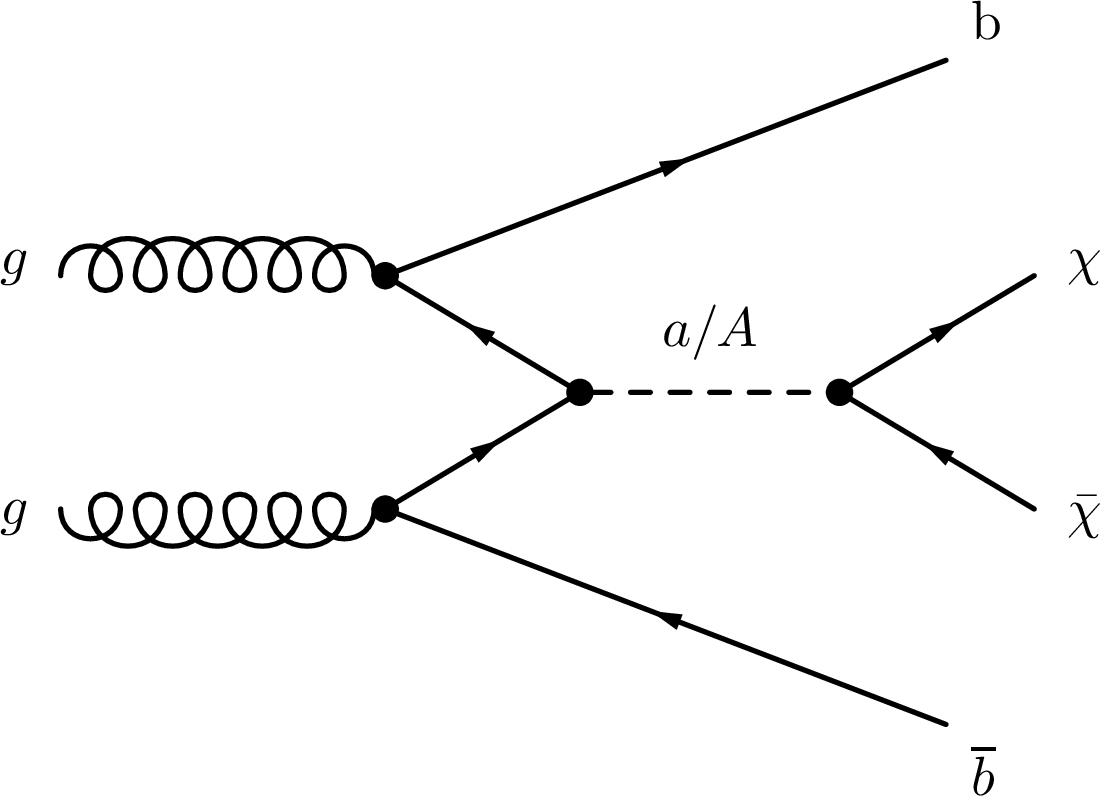
png pdf |
Figure 1-a:
Leading Feynman diagrams for the $ \mathrm{b}\overline{\mathrm{b}}+\chi{\overline{\chi}} $ process in the 2HDM+a model. |
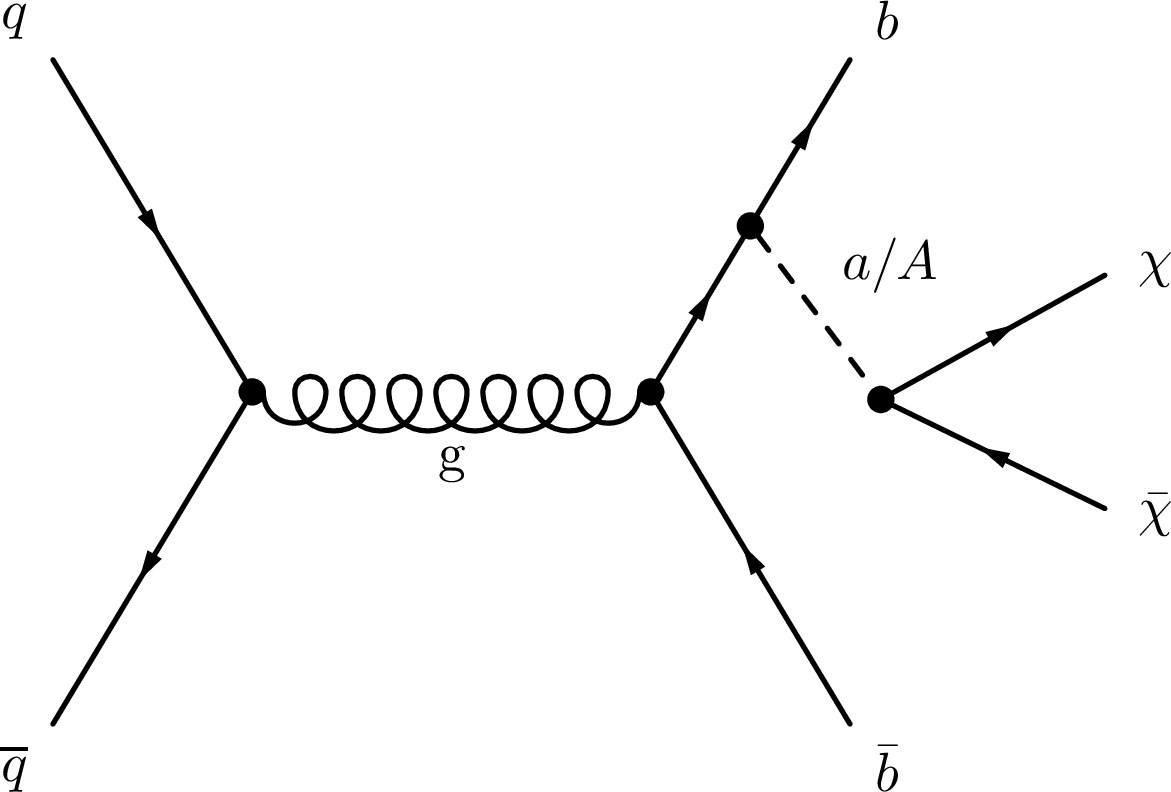
png pdf |
Figure 1-b:
Leading Feynman diagrams for the $ \mathrm{b}\overline{\mathrm{b}}+\chi{\overline{\chi}} $ process in the 2HDM+a model. |
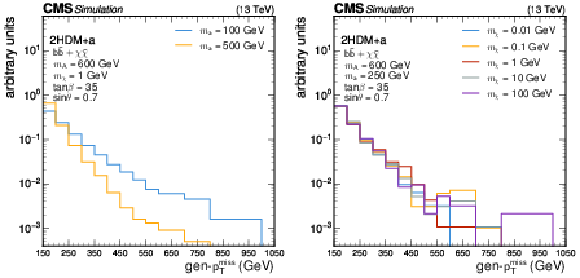
png pdf |
Figure 2:
Normalized (to unity) shape of generator-level $ p_{\mathrm{T}}^\text{miss} $ distribution for two illustrative lighter pseudoscalar masses $ m_{\textrm{a}} $ (left) and for five illustrative DM masses $ m_{\chi} $ (right). |
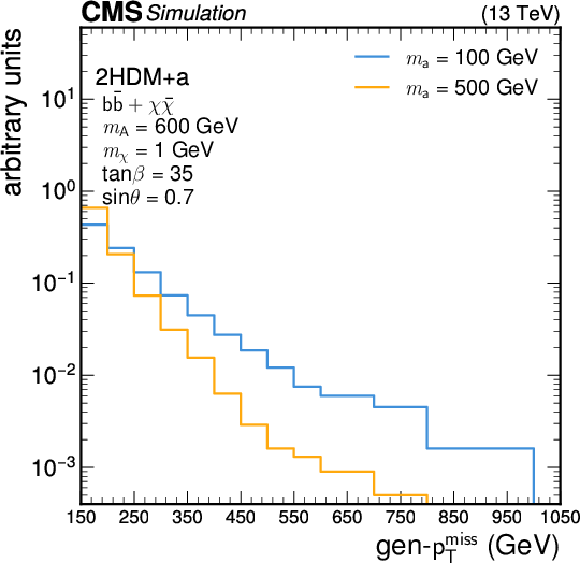
png pdf |
Figure 2-a:
Normalized (to unity) shape of generator-level $ p_{\mathrm{T}}^\text{miss} $ distribution for two illustrative lighter pseudoscalar masses $ m_{\textrm{a}} $ (left) and for five illustrative DM masses $ m_{\chi} $ (right). |

png pdf |
Figure 2-b:
Normalized (to unity) shape of generator-level $ p_{\mathrm{T}}^\text{miss} $ distribution for two illustrative lighter pseudoscalar masses $ m_{\textrm{a}} $ (left) and for five illustrative DM masses $ m_{\chi} $ (right). |
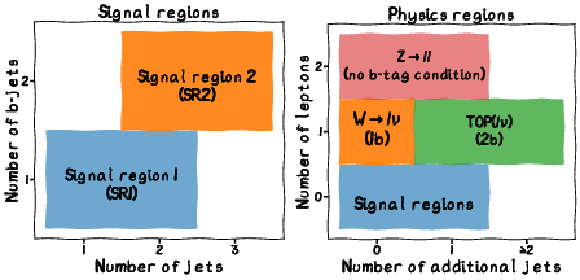
png pdf |
Figure 3:
Definition of SR1 and SR2 in terms of jet multiplicity (left), and CR and SR definition in the lepton multiplicity and additional jet multiplicity plane (right). The categories depend on the number and flavor of leptons, and the number of jets in an event. |

png pdf |
Figure 3-a:
Definition of SR1 and SR2 in terms of jet multiplicity (left), and CR and SR definition in the lepton multiplicity and additional jet multiplicity plane (right). The categories depend on the number and flavor of leptons, and the number of jets in an event. |
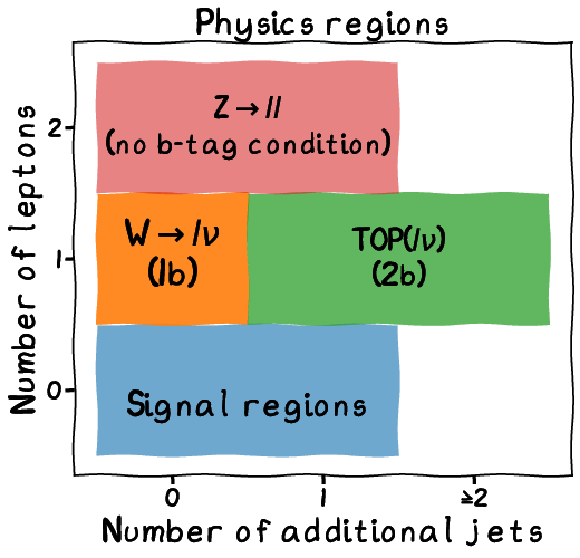
png pdf |
Figure 3-b:
Definition of SR1 and SR2 in terms of jet multiplicity (left), and CR and SR definition in the lepton multiplicity and additional jet multiplicity plane (right). The categories depend on the number and flavor of leptons, and the number of jets in an event. |

png pdf |
Figure 4:
QCD background contribution in the QCD CR (black and pink dots) in the 2b category using 2017 data. The exponential is fitted in the range $ \min(\Delta\phi (\text{jet}, {\vec p}_{\mathrm{T}}^{\kern1pt\text{miss}}) ) < $ 0.3, checked to fit well in the range 0.3 $ < \min(\Delta\phi (\text{jet}, {\vec p}_{\mathrm{T}}^{\kern1pt\text{miss}}) ) < $ 0.5, and extrapolated to the SRs for $ \min(\Delta\phi (\text{jet}, {\vec p}_{\mathrm{T}}^{\kern1pt\text{miss}}) ) > $ 0.5. The process is performed for the 1b as well as 2b categories for all years. |

png pdf |
Figure 5:
Observed and predicted $ p_{\mathrm{T}}^\text{miss} $ ($ U $) distributions in the 1b category. The red lines divide the plot into three parts: the first part shows the SR, the second part the $ \mathrm{Z}(\ell\ell)+\text{jets} $ CR, and the third part the $ \mathrm{W}(\ell\nu)+\text{jets} $ CR. The bottom plot shows the ratio of observed and predicted (both postfit and prefit) distributions along with an uncertainty band that includes both the systematic and statistical components. |
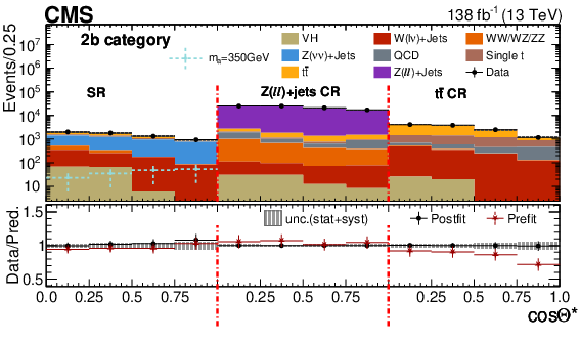
png pdf |
Figure 6:
Observed and predicted $ \cos\Theta^{*} $ distributions in the 2b category. The red lines divide the plot into three parts: the first part shows the SR, the second part the $ \mathrm{Z}(\nu\nu)+\text{jets} $ CR, and the third part the $ \mathrm{t} \overline{\mathrm{t}} $ CR. The bottom plot shows the ratio of observed and predicted (both postfit and prefit) distributions along with an uncertainty band that includes both the systematic and statistical components. |
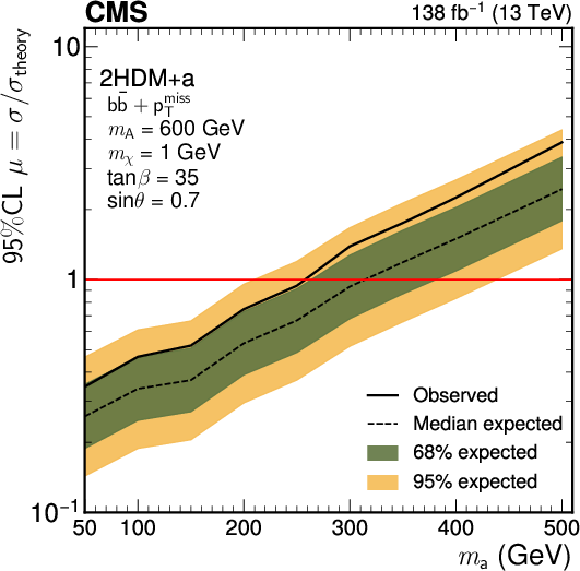
png pdf |
Figure 7:
The 95% CL upper limit on the signal strength modifier of DM produced in association with a pair of bottom quarks for $ m_{\textrm{A}}= $ 600 GeV, $ \sin\theta= $ 0.7, $ m_{\chi}= $ 1 GeV, and $ \tan\beta= $ 35, for the combination of SR1 and SR2. The green and yellow bands show the $ \pm $ 1 and $ \pm $ 2 standard deviations from expected limits. The mass points below the red line are excluded. |

png pdf |
Figure 8:
Observed and expected upper limits at 95% CL on the signal strength in the $ m_{\textrm{a}} $-$ \tan\beta $ (upper left), $ m_{\textrm{a}} $-$ \sin\theta $ (upper right), and $ m_{\textrm{a}} $-$ m_{\chi} $ (lower) planes. The shaded area bounded by solid black line is excluded, with, the dotted grey line ($ m_{\textrm{a}} = 2m_{\chi} $) separating on-shell and off-shell productions for the lower plot. |
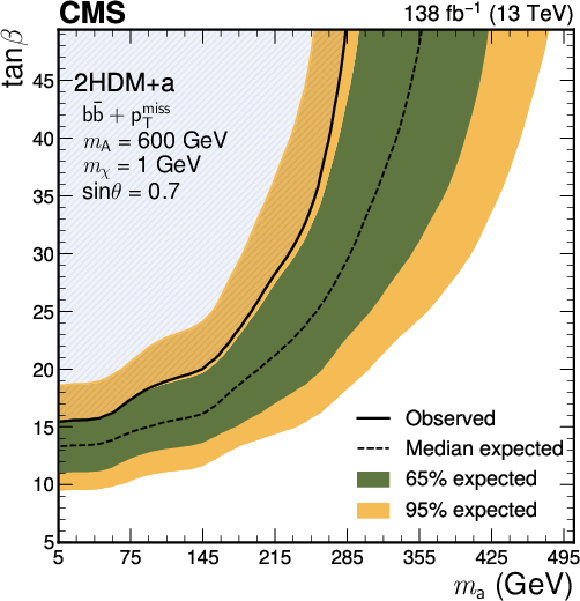
png pdf |
Figure 8-a:
Observed and expected upper limits at 95% CL on the signal strength in the $ m_{\textrm{a}} $-$ \tan\beta $ (upper left), $ m_{\textrm{a}} $-$ \sin\theta $ (upper right), and $ m_{\textrm{a}} $-$ m_{\chi} $ (lower) planes. The shaded area bounded by solid black line is excluded, with, the dotted grey line ($ m_{\textrm{a}} = 2m_{\chi} $) separating on-shell and off-shell productions for the lower plot. |

png pdf |
Figure 8-b:
Observed and expected upper limits at 95% CL on the signal strength in the $ m_{\textrm{a}} $-$ \tan\beta $ (upper left), $ m_{\textrm{a}} $-$ \sin\theta $ (upper right), and $ m_{\textrm{a}} $-$ m_{\chi} $ (lower) planes. The shaded area bounded by solid black line is excluded, with, the dotted grey line ($ m_{\textrm{a}} = 2m_{\chi} $) separating on-shell and off-shell productions for the lower plot. |
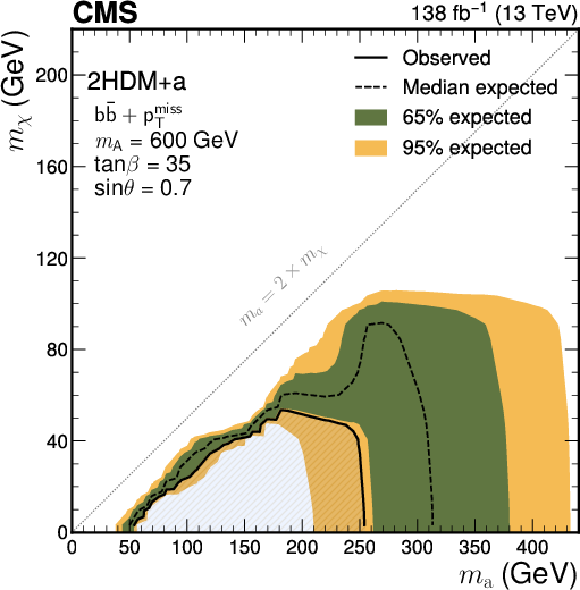
png pdf |
Figure 8-c:
Observed and expected upper limits at 95% CL on the signal strength in the $ m_{\textrm{a}} $-$ \tan\beta $ (upper left), $ m_{\textrm{a}} $-$ \sin\theta $ (upper right), and $ m_{\textrm{a}} $-$ m_{\chi} $ (lower) planes. The shaded area bounded by solid black line is excluded, with, the dotted grey line ($ m_{\textrm{a}} = 2m_{\chi} $) separating on-shell and off-shell productions for the lower plot. |
| Tables | |

png pdf |
Table 1:
Preselection criteria applied to all the events entering the SRs and CRs. |
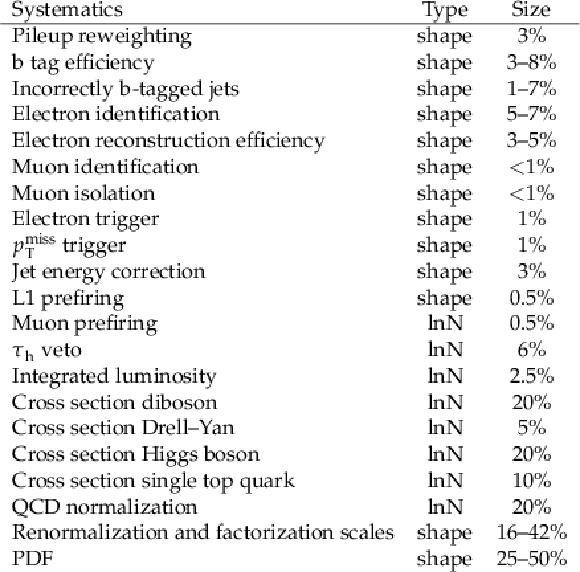
png pdf |
Table 2:
Systematic uncertainties affecting the shape and normalization ($ \ln N$) of the signal and background predictions with an impact greater than 0.5%. |
| Summary |
| A search for dark matter produced in association with a pair of bottom quarks is performed using data collected by the CMS detector in 2016--2018, corresponding to an integrated luminosity of 138 fb$ ^{-1} $. The analysis searches for a possible signal by using two independent categories with different multiplicities of jets reconstructed as originating from a bottom quark. The results are interpreted in the framework of a simplified model, namely a type-II two-Higgs-doublet model with an additional pseudoscalar singlet (2HDM+a). It is the first search at the LHC to probe dark matter (DM) produced in association with two nonresonant bottom quarks in this model. This search performs best in the high-$ \tan\beta $ phase space, where the signal production cross section is enhanced. This provides a complementary search to constrain the 2HDM+a model parameter phase space in the region where other DM searches are less sensitive. The lighter pseudoscalar mass below 260 GeV is excluded at 95% confidence level for $ \tan\beta= $ 35, $ \sin\theta= $ 0.7, and $ m_{\textrm{A}}= $ 600 GeV. |
| References | ||||
| 1 | N. Deruelle and J.-P. Uzan | The Lambda-CDM model of the hot Big Bang | OUP Academic, 2018 link |
|
| 2 | Planck Collaboration | Planck 2018 results. I. Overview and the cosmological legacy of Planck | Astron. Astrophys. 641 (2020) A1 | 1807.06205 |
| 3 | K. Freese | Status of Dark Matter in the Universe | Int. J. Mod. Phys. 1 (2017) 325 | 1701.01840 |
| 4 | J. L. Feng | Dark Matter Candidates from Particle Physics and Methods of Detection | Ann. Rev. Astron. Astrophys. 48 (2010) 495 | 1003.0904 |
| 5 | V. Trimble | Existence and nature of dark matter in the universe | Annual Review of Astronomy and Astrophysics. 25 (1987) 425 | |
| 6 | G. Jungman, M. Kamionkowski, and K. Griest | Supersymmetric dark matter | Phys. Rept. 267 (1996) 195 | hep-ph/9506380 |
| 7 | CMS Collaboration | Dark sector searches with the CMS experiment | Submitted to Phys. Rept, 2024 | CMS-EXO-23-005 2405.13778 |
| 8 | ATLAS Collaboration | Constraints on simplified dark matter models involving an s-channel mediator with the ATLAS detector in pp collisions at $ \sqrt{s} = $ 13 TeV | no.~10, 1102, 2024 EPJC 84 (2024) |
2404.15930 |
| 9 | CMS Collaboration | Search for dark matter produced in association with a single top quark or a top quark pair in proton-proton collisions at $ \sqrt{s}= $ 13 TeV | JHEP 03 (2019) 141 | CMS-EXO-18-010 1901.01553 |
| 10 | ATLAS Collaboration | Search for dark matter produced in association with a single top quark in TeV collisions with the ATLAS detector | EPJC 81 (2021) 860 | 2011.09308 |
| 11 | ATLAS Collaboration | Search for dark matter produced in association with a single top quark and an energetic W boson in 13 TeV collisions with the ATLAS detector | EPJC 83 (2023) 603 | 2211.13138 |
| 12 | ATLAS Collaboration | Search for new particles in final states with a boosted top quark and missing transverse momentum in proton-proton collisions at = 13 TeV with the ATLAS detector | (May, ) 263, 2024 J. High Energy Phys. 0 (2024) 5 |
2402.16561 |
| 13 | CMS Collaboration | Search for dark matter particles produced in association with a top quark pair at $ \sqrt{s} = $ 13 TeV | PRL 122 (2019) 011803 | CMS-EXO-16-049 1807.06522 |
| 14 | ATLAS Collaboration | Constraints on spin-0 dark matter mediators and invisible Higgs decays using ATLAS 13 TeV pp collision data with two top quarks and missing transverse momentum in the final state | EPJC 83 (2023) 503 | 2211.05426 |
| 15 | CMS Collaboration | Search for dark matter produced in association with heavy-flavor quark pairs in proton-proton collisions at $ \sqrt{s}= $ 13 TeV | EPJC 77 (2017) 845 | CMS-EXO-16-005 1706.02581 |
| 16 | CMS Collaboration | Searches for physics beyond the standard model with the $ M_\mathrm{ T2} $ variable in hadronic final states with and without disappearing tracks in proton-proton collisions at $ \sqrt{s}= $ 13 TeV | EPJC 80 (2020) 3 | CMS-SUS-19-005 1909.03460 |
| 17 | CMS Collaboration | Search for dark matter produced in association with a Higgs boson decaying to a pair of bottom quarks in proton-proton collisions at $ \sqrt{s}=$ 13 TeV | no.~3, 280, 2019 EPJC 79 (2019) |
CMS-EXO-16-050 1811.06562 |
| 18 | ATLAS Collaboration | Search for dark matter produced in association with bottom or top quarks in $ \sqrt{s}= $ 13 TeV pp collisions with the ATLAS detector | EPJC 78 (2018) 18 | 1710.11412 |
| 19 | ATLAS Collaboration | Search for new phenomena in final states with b-jets and missing transverse momentum in = 13 TeV pp collisions with the ATLAS detector | J. High Energy Phys. 05 (2021) 93 | 2101.12527 |
| 20 | ATLAS Collaboration | Search for dark matter produced in association with a Standard Model Higgs boson decaying into b-quarks using the full Run 2 dataset from the ATLAS detector | J. High Energy Phys. 11 (2021) 209 | 2108.13391 |
| 21 | D. Abercrombie et al. | Dark Matter benchmark models for early LHC Run-2 Searches: Report of the ATLAS/CMS Dark Matter Forum | Phys. Dark Univ. 27 (2020) 100371 | 1507.00966 |
| 22 | M. Bauer, U. Haisch, and F. Kahlhoefer | Simplified dark matter models with two Higgs doublets: I. Pseudoscalar mediators | JHEP 05 (2017) 138 | 1701.07427 |
| 23 | T. Abe et al. | LHC Dark Matter Working Group: Next-generation spin-0 dark matter models | Phys. Dark Univ. 27 (2020) 100351 | 1810.09420 |
| 24 | ATLAS Collaboration | Search for heavy ZZ resonances in the $ \ell ^+\ell ^-\ell ^+\ell ^- $ and $ \ell ^+\ell ^-\nu \bar{\nu } $ final states using proton -proton collisions at $ \sqrt{s}= $ 13 TeV with the ATLAS detector | EPJC 78 (2018) 293 | 1712.06386 |
| 25 | ATLAS Collaboration | Search for heavy resonances decaying into $ WW $ in the $ e\nu\mu\nu $ final state in pp collisions at $ \sqrt{s}= $ 13 TeV with the ATLAS detector | EPJC 78 (2018) 24 | 1710.01123 |
| 26 | CMS Collaboration | Search for beyond the standard model Higgs bosons decaying into a $ \mathrm{b\overline{b}} $ pair in pp collisions at $ \sqrt{s} = $ 13 TeV | JHEP 08 (2018) 113 | CMS-HIG-16-018 1805.12191 |
| 27 | ATLAS Collaboration | Constraints on mediator-based dark matter and scalar dark energy models using $\sqrt{s} = $ 13 TeV pp collision data collected by the ATLAS detector | JHEP 05 (2019) 142 | 1903.01400 |
| 28 | J. Alwall et al. | The automated computation of tree-level and next-to-leading order differential cross sections, and their matching to parton shower simulations | JHEP 07 (2014) 079 | 1405.0301 |
| 29 | S. Frixione, P. Nason, and C. Oleari | Matching NLO QCD computations with Parton Shower simulations: the POWHEG method | JHEP 11 (2007) 070 | 0709.2092 |
| 30 | S. Alioli, P. Nason, C. Oleari, and E. Re | A general framework for implementing NLO calculations in shower Monte Carlo programs: the POWHEG BOX | JHEP 06 (2010) 043 | 1002.2581 |
| 31 | T. Sjöstrand et al. | An introduction to PYTHIA 8.2 | Computer Physics Communications 191 (2015) 159 | 1410.3012 |
| 32 | NNPDF Collaboration | Parton distributions for the LHC Run II | JHEP 04 (2015) 040 | 1410.8849 |
| 33 | CMS Collaboration | Event generator tunes obtained from underlying event and multiparton scattering measurements | EPJC 76 (2016) 155 | CMS-GEN-14-001 1512.00815 |
| 34 | P. Skands, S. Carrazza, and J. Rojo | Tuning PYTHIA 8.1: the Monash 2013 tune | EPJC 74 (2014) 3024 | 1404.5630 |
| 35 | GEANT4 Collaboration | GEANT 4---a simulation toolkit | NIM A 506 (2003) 250 | |
| 36 | CMS Collaboration | The CMS trigger system | JINST 12 (2017) P01020 | CMS-TRG-12-001 1609.02366 |
| 37 | CMS Collaboration | The CMS Experiment at the CERN LHC | JINST 3 (2008) S08004 | |
| 38 | CMS Collaboration | Particle-flow reconstruction and global event description with the CMS detector | JINST 12 (2017) P10003 | CMS-PRF-14-001 1706.04965 |
| 39 | CMS Collaboration | Performance of reconstruction and identification of $ \tau $ leptons decaying to hadrons and $ \nu_\tau $ in pp collisions at $ \sqrt{s}= $ 13 TeV | JINST 13 (2018) P10005 | CMS-TAU-16-003 1809.02816 |
| 40 | CMS Collaboration | Jet energy scale and resolution in the CMS experiment in pp collisions at 8 TeV | JINST 12 (2017) P02014 | CMS-JME-13-004 1607.03663 |
| 41 | CMS Collaboration | Performance of missing transverse momentum reconstruction in proton-proton collisions at $ \sqrt{s} = $ 13 TeV using the CMS detector | JINST 14 (2019) P07004 | CMS-JME-17-001 1903.06078 |
| 42 | D. Contardo et al. | Technical Proposal for the Phase-II Upgrade of the CMS Detector | Technical report, Geneva, 2015 link |
|
| 43 | M. Cacciari, G. P. Salam, and G. Soyez | The anti-$ k_{\mathrm{T}} $ jet clustering algorithm | JHEP 04 (2008) 063 | 0802.1189 |
| 44 | CMS Collaboration | Pileup mitigation at CMS in 13 TeV data | JINST 15 (2020) P09018 | CMS-JME-18-001 2003.00503 |
| 45 | D. Bertolini, P. Harris, M. Low, and N. Tran | Pileup Per Particle Identification | JHEP 10 (2014) 059 | 1407.6013 |
| 46 | CMS Collaboration | Identification of heavy-flavour jets with the CMS detector in pp collisions at 13 TeV | JINST 13 (2018) P05011 | CMS-BTV-16-002 1712.07158 |
| 47 | CMS Collaboration | Identification of hadronic tau lepton decays using a deep neural network | JINST 17 (2022) P07023 | CMS-TAU-20-001 2201.08458 |
| 48 | CMS Collaboration | Electron and photon reconstruction and identification with the CMS experiment at the CERN LHC | JINST 16 (2021) P05014 | CMS-EGM-17-001 2012.06888 |
| 49 | CMS Collaboration | Performance of the CMS muon detector and muon reconstruction with proton-proton collisions at $ \sqrt{s}= $ 13 TeV | JINST 13 (2018) P06015 | CMS-MUO-16-001 1804.04528 |
| 50 | A. J. Barr | Measuring slepton spin at the LHC | JHEP 02 (2006) 042 | hep-ph/0511115 |
| 51 | CMS Collaboration | Precision luminosity measurement in proton-proton collisions at $ \sqrt{s} = $ 13 TeV in 2015 and 2016 at CMS | EPJC 81 (2021) 800 | CMS-LUM-17-003 2104.01927 |
| 52 | CMS Collaboration | CMS luminosity measurement for the 2017 data-taking period at $ \sqrt {s} = $ 13 TeV | CMS Physics Analysis Summary, 2018 link |
CMS-PAS-LUM-17-004 |
| 53 | CMS Collaboration | CMS luminosity measurement for the 2018 data-taking period at $ \sqrt {s} = $ 13 TeV | CMS Physics Analysis Summary, 2019 link |
CMS-PAS-LUM-18-002 |
| 54 | CMS Collaboration | Measurements of Inclusive $ W $ and $ Z $ Cross Sections in pp Collisions at $ \sqrt{s}= $ 7 TeV | JHEP 01 (2011) 080 | CMS-EWK-10-002 1012.2466 |
| 55 | CMS Collaboration | Measurement of the inelastic proton-proton cross section at $ \sqrt{ s}= $ 13 TeV | JHEP 07 (2018) 161 | CMS-FSQ-15-005 1802.02613 |
| 56 | CMS Collaboration | Observation of the associated production of a single top quark and a $ W $ boson in pp collisions at $\sqrt{s} = $ 8 TeV | PRL 112 (2014) 231802 | CMS-TOP-12-040 1401.2942 |
| 57 | CMS Collaboration | Measurement of the ZZ production cross section and Z $ \to \ell^+\ell ^-\ell'^+\ell'^- $ branching fraction in pp collisions at $\sqrt{s} = $ 13 TeV | PLB 763 (2016) 280 | CMS-SMP-16-001 1607.08834 |
| 58 | CMS Collaboration | Measurement of the inclusive and differential WZ production cross sections, polarization angles, and triple gauge couplings in pp collisions at $ \sqrt{s} = $ 13 TeV | JHEP 07 (2022) 032 | CMS-SMP-20-014 2110.11231 |
| 59 | J. Butterworth et al. | PDF4LHC recommendations for LHC Run II | J. Phys. G: Nucl. Part. Phys. 43 (2016) 023001 | 1510.03865 |
| 60 | S. Dulat et al. | New parton distribution functions from a global analysis of quantum chromodynamics | PRD 93 (2016) 033006 | 1506.07443 |
| 61 | L. A. Harland-Lang, A. D. Martin, P. Motylinski, and R. S. Thorne | Parton distributions in the LHC era: MMHT 2014 PDFs | EPJC 75 (2015) 204 | 1412.3989 |
| 62 | LHC Higgs Cross Section Working Group | Handbook of LHC Higgs cross sections: 3. Higgs properties | CERN Report CERN-2013-004, 2013 link |
1307.1347 |
| 63 | T. Junk | Confidence level computation for combining searches with small statistics | NIM A 434 (1999) 435 | hep-ex/9902006 |
| 64 | A. L. Read | Presentation of search results: the CL$ _{s} $ technique | JPG 28 (2002) 2693 | |
| 65 | G. Cowan, K. Cranmer, E. Gross, and O. Vitells | Asymptotic formulae for likelihood-based tests of new physics | EPJC 71 (2011) 1554 | 1007.1727 |
| 66 | CMS Collaboration | HEPData record for this analysis | link | |

|
Compact Muon Solenoid LHC, CERN |

|

|

|

|

|

|